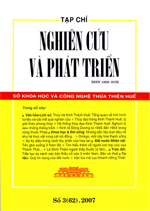Những dẫn liệu ban đầu về khu hệ thực vật vùng cát nội đồng tỉnh Thừa Thiên Huế/The initial documents of botanical system zone in Thừa Thiên Huế provincial sandy hinterland
Tóm tắt
Vùng cát nội đồng ở miền Trung Việt Nam nói chung và tỉnh Thừa Thiên Huế nói riêng là một tiểu vùng sinh thái khắc nghiệt. Bộ mặt thực vật ở đó đã thể hiện được những đặc điểm thích nghi qua nhiều thời kỳ. Nhiều quần thể sinh thái hình thành và ổn định, góp phần cải thiện tiểu khí hậu, bảo vệ môi trường, giảm bớt khó khăn trong hoạt động sống của con người tại chỗ. Tuy thế, do chiến tranh kéo dài, cộng với việc khai thác thô bạo, thiếu kiểm soát của chính những người dân địa phương, nên các quần thể sinh thái bị phá vỡ, tình trạng hoang hóa ngày càng mở rộng, nhiều nơi có nguy cơ sa mạc hóa. Mặc dù trong những thập niên vừa qua, ngành lâm nghiệp đã có nhiều cố gắng, vận dụng các dự án và chương trình trồng rừng phủ xanh, nhưng vẫn không thể bù đắp nổi những gì đã mất. Kết quả nghiên cứu cho thấy, những vết tích lổ đổ của những cánh rừng rậm ngày xưa vẫn còn lưu lại. Đó là, hàng trăm hecta rú cát nội đồng phân thành từng mảng không liên hoàn, với trên 30 loài cây gỗ bản địa, phần lớn đang trên đường thoái hóa chất lượng sống. Nhiều loài cây bụi phân bố manh mún thể hiện rõ nét diễn thế giật lùi. Nhiều loài cỏ chịu hạn cực độ trên những trảng cát rộng hàng trăm hecta báo hiệu nguy cơ sa mạc hóa. Tất cả đều tồn tại trên nền cát trắng bạc màu, phần lớn chua và khô hạn. Nhìn chung, có ít nhất 5 tiểu hệ sinh thái tồn tại phổ biến trên khu vực. Trong đó, hiện hữu những hội đoàn (ưu hợp) thực vật chỉ thị đất đặc trưng. Những hệ sinh thái đó cũng chứa đựng những nguồn gen có giá trị bảo vệ môi trường, bảo vệ sức khỏe cộng đồng và phát triển kinh tế. Trong đó, có nhiều loài cây gỗ bản địa có khả năng tái sinh mạnh, có thể làm vật liệu trồng rừng phòng hộ bền vững.
ABSTRACT
The interior-field sand area in the Middle Vietnam in general and in Thừa Thiên Huế province in particular is a small severe ecological area. The flora aspect of this area has shown adaptable features over various time periods. Lots of ecological communities have been formed and become stable, which contributes to the improvement of local weather, enviroment protection and the overcoming of local people’s daily-life challenges. However, the prolonged wars, together with local peole’s unconscious and uncontrollable exploitation have led to the fact that the ecological community has been violated and the following has been expanded or even become wastelands.
Over the past few decades, the Forestry Industry has been making lots of effort to employ many afforestation projects and programs; however these measures could not compensate for the real loss. The study results show the scattered traces of the remaining ancient dense forests. It is hundreds of hectares of scattered uncontinous interior-hinterland small forests with more than 30 local timber trees species, most of which are on the way of degradation. Many kinds of shrub are tatteredly distributed, which shows the features of a backward trend. Many extreme drough-bearing species of grass on the hundred-hectare sand-plots also signal a wasteland risk. All is existing on the impoverished white sand surface, the biggest area of which is acid and alkaline soil. Generally, there are at least 5 types of micro-ecologies existing in the area. In these types, there are many particular soil indicated vegetale population. These micro-ecologies contain gene sources which are valuable to environment, people’s health protection and economic development. In these types, there are also been many local kinds of timber trees with strong reproductive ability, which can be used as resources for sustainable protective afforestation.

